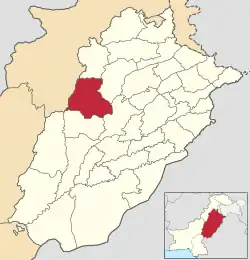Bhakkar
بهكّر | |
|---|---|
 Jamia Masjid, Mankera | |
 Location of Bhakkar District within Punjab. | |
| Coordinates: 31°37′23″N 71°03′45″E / 31.6230°N 71.0626°E | |
| Country | |
| Province | |
| Division | Mianwali |
| Established | 1981 |
| Headquarters | Bhakkar |
| Tehsils (4) | |
| Government | |
| • Type | District Administration |
| • Deputy Commissioner | Syed Musa Raza |
| • District Police Officer | N/A |
| • District Health Officer | N/A |
| Area [1]: 1 | |
| • Total | 8,153 km2 (3,148 sq mi) |
| Population (2023)[2] | |
| • Total | 1,957,470 |
| • Density | 240/km2 (620/sq mi) |
| Time zone | UTC+5 (PKT) |
| Languages | Saraiki, Punjabi |
| Website | bhakkar |
Bhakkar District (Urdu: ضِلع بهكّر), is a district in the province of Punjab, Pakistan. The district was created out of parts of Mianwali in 1982,[3] and has the city of Bhakkar as its headquarters. Part of its area consists of a riverine tract along the Indus, called Kaccha, while most of the district area lies in the desolate plain of the Thal Desert.[4] The main languages spoken in the district are Saraiki (79.97%), Punjabi (10.18%), Urdu (7.14%), and Pashto (2.33%).[5]
It is located in the west of the Punjab province, Bhakkar district is bordered by Layyah to its south, Jhang to its south east, Dera Ismail Khan to its west, Khushab to its north east, and Mianwali to its north.
Administration
The district is administratively divided into four Tehsils and 64 Union Councils:[6]
Khansar Union Council is one of the major Union Councils in Bhakkar. Mari Shah Sakhira Union Council is very close to Bhakkar District boundary.
Demographics
| Year | Pop. | ±% p.a. |
|---|---|---|
| 1951 | 233,733 | — |
| 1961 | 332,882 | +3.60% |
| 1972 | 500,498 | +3.78% |
| 1981 | 665,884 | +3.22% |
| 1998 | 1,051,456 | +2.72% |
| 2017 | 1,647,852 | +2.39% |
| 2023 | 1,957,470 | +2.91% |
| Sources:[7] | ||
At the time of the 2017 census, Bhakkar district had 267,317 households and a population of 1,647,852. Bhakkar had a sex ratio of 954 females per 1000 males and a literacy rate of 51.82% - 65.05% for males and 38.08% for females. 259,654 (15.76%) lived in urban areas. 456,121 (27.68%) were under 10 years of age.[5] In 2023, the district had 313,559 households and a population of 1,957,470.[2]
Religion
| Religion | Population (1941)[8]: 62–63 | Percentage (1941) | Population (2017)[5] | Percentage (2017) |
|---|---|---|---|---|
| Islam |
169,276 | 82.16% | 1,646,014 | 99.89% |
| Hinduism |
32,740 | 15.89% | 13 | 0% |
| Sikhism |
3,996 | 1.94% | — | — |
| Christianity |
23 | 0.01% | 1,661 | 0.1% |
| Ahmadi | — | — | 112 | 0.01% |
| Others [lower-alpha 3] | 0 | 0% | 52 | 0% |
| Total Population | 206,035 | 100% | 1,647,852 | 100% |
Languages
At the time of the 2017 census, 79.97% of the population spoke Saraiki, 10.18% Punjabi, 7.14% Urdu and 2.33% Pashto as their first language.[5]
Education
According to the census held in 2017, the literacy rate of Bhakkar is about 55%. There are 19 colleges, and 1300 primary, elementary, secondary, and higher secondary schools.
Notable people
- Rasheed Akbar Khan Nawani (politician)
- Muhammad Sana Ullah Khan Masti Khel (politician)
- Inamullah Niazi (politician)
- Lekh Raj Batra, a distinguished mycologist and linguist
See also
Notes
- ↑ 1941 figures are for Bhakkar tehsil of the then Mianwali District, which roughly corresponds to present-day Bhakkar district. Historic district borders may not be an exact match in the present-day due to various bifurcations to district borders — which since created new districts — throughout the historic Punjab Province region during the post-independence era that have taken into account population increases.
- ↑ 1941 census: Including Ad-Dharmis
- ↑ Including Jainism, Buddhism, Zoroastrianism, Judaism, or not stated
References
- ↑ 1998 District Census report of Bhakkar. Census publication. Vol. 74. Islamabad: Population Census Organization, Statistics Division, Government of Pakistan. 2000.
- 1 2 "TABLE 1 : HOUSEHOLDS, POPULATION, HOUSEHOLD SIZE AND ANNUAL GROWTH RATE" (PDF). www.pbscensus.gov.pk. Pakistan Bureau of Statistics. 2023.
- ↑ "Bhakkar". Punjab Portal, Government of Punjab websitel. Archived from the original on 6 August 2022. Retrieved 30 November 2022.
- ↑ Bhakkar Tahsil - Imperial Gazetteer of India, v. 8, p. 43
- 1 2 3 4 5 "District Wise Results / Tables (Census - 2017)". www.pbscensus.gov.pk. Pakistan Bureau of Statistics.
- 1 2 3 4 5 "Tehsils & Unions in the District of Bhakkar". Government of Pakistan website. 9 February 2012. Archived from the original on 9 February 2012. Retrieved 30 November 2022.
- ↑ "Population by administrative units 1951-1998" (PDF). Pakistan Bureau of Statistics.
- ↑ "CENSUS OF INDIA, 1941 VOLUME VI PUNJAB PROVINCE". Retrieved 21 July 2022.
